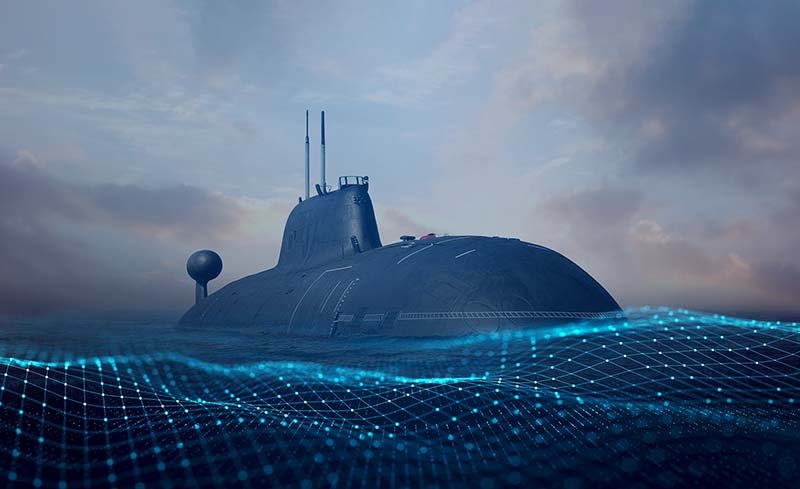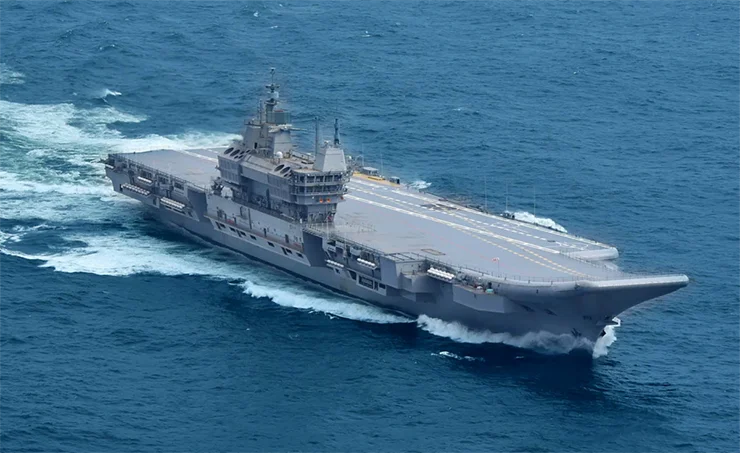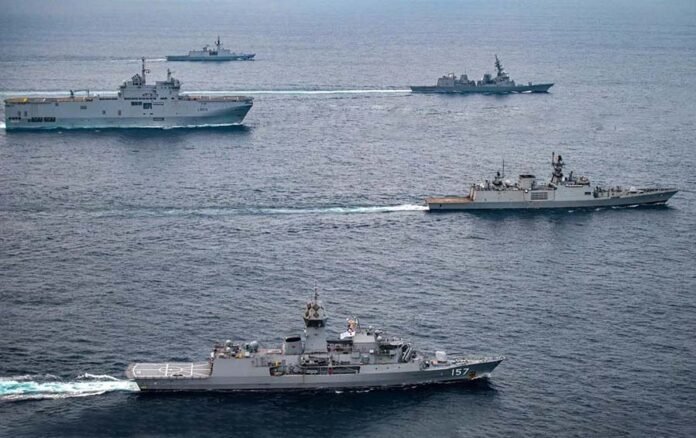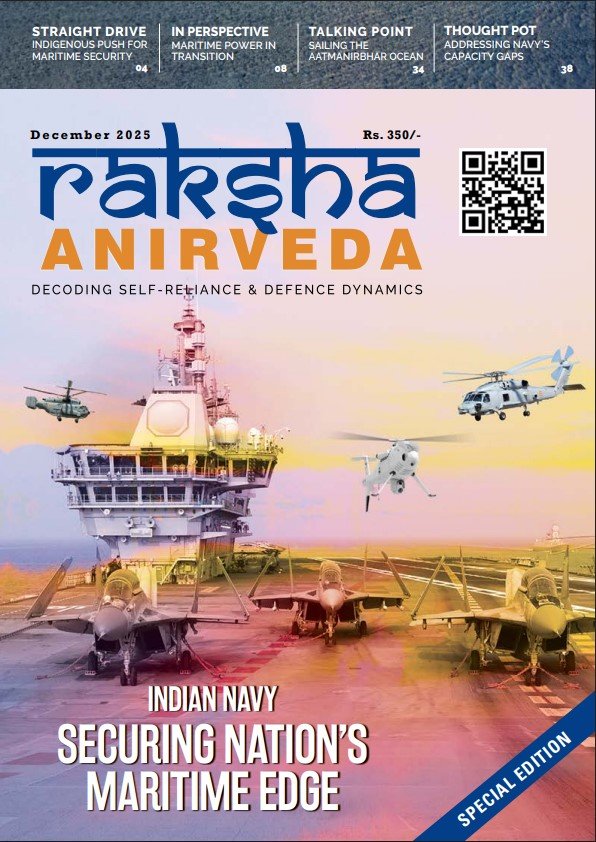The Indian Navy with its strategic mandate to safeguard over 7,500 kilometres of coastline and a vast Exclusive Economic Zone (EEZ) of over 2 million square kilometres, is a cornerstone of India’s national security and economic development.
The Indo-Pacific’s emergence as the epicentre of global geopolitics has amplified the navy’s role in ensuring maritime security, power projection and regional stability. Central to its modernisation and operational goals is its commitment to an ‘Aatmanirbhar Bharat’, which has propelled the Navy on a transformative journey marked by innovation, indigenisation and a steadfast focus on sustainability.
Indigenisation Imperative: Legacy of Progress
Building Ships for the Future: The Indian Navy has consistently led the charge in indigenisation across the armed forces, with over 75% of its platforms being constructed domestically. The commissioning of the INS Vikrant, India’s first indigenous aircraft carrier, in 2022 marked a monumental achievement. This flagship vessel constructed by Cochin Shipyard Limited (CSL) demonstrates India’s capability to design and manufacture complex naval platforms. The INS Vikrant, weighing over 40,000 tons, incorporates indigenous, state-of-the-art technologies, from advanced combat management systems to communication networks.
The Navy’s indigenisation efforts extend beyond aircraft carriers. The Project 15B guided-missile destroyers (Visakhapatnam-class) and the Project 17A stealth frigates, designed and built by Mazagon Dock Shipbuilders Limited (MDL) and Garden Reach Shipbuilders and Engineers (GRSE), highlight India’s growing prowess in designing advanced warships. Equipped with indigenous radars, sonar systems and weapons, these platforms ensure a technologically robust fleet capable of tackling multifaceted maritime challenges.
The Indian Navy has led the charge in indigenisation across the armed forces, with over 75% of its platforms being constructed domestically. The commissioning of the INS Vikrant in 2022 marked a monumental achievement. This flagship vessel constructed by Cochin Shipyard Limited demonstrates India’s capability to design and manufacture complex naval platforms
Auxiliary vessels, including survey ships such as the INS Nirdeshak and fleet support ships, have also been indigenously developed, showcasing the navy’s holistic approach to fleet sustainability. These vessels play a pivotal role in supporting India’s expansive maritime operations and contributing to oceanographic research, critical for maritime domain awareness.
Underwater Strength: Submarine Programmes
India’s strategic focus on its submarine capabilities is evident in its ambitious indigenous programmes. The Arihant-class nuclear-powered ballistic missile submarines, built under the Advanced Technology Vessel (ATV) programme, reflect India’s ability to develop critical strategic platforms. Complementing these are the Kalvari-class diesel-electric submarines, produced under Project 75 in collaboration with France’s Naval Group. With plans for Project 75I to be entirely indigenous, the Navy is set to enhance its underwater combat edge, ensuring stealth, endurance and multi-role adaptability.
HAL is Revolutionising India’s Naval Aviation
The Indian Navy’s aviation wing is undergoing a paradigm shift towards indigenisation, with a focus on developing homegrown platforms to meet its operational requirements. The Hindustan Aeronautics Limited (HAL) is at the forefront, developing the Twin-Engine Deck-Based Fighter (TEDBF) to replace the Navy’s MiG-29K fleet. Designed for operations on aircraft carriers, the TEDBF will feature advanced stealth capabilities, indigenous avionics and next-generation weapons systems.
Indigenous rotary-wing platforms such as the Advanced Light Helicopter (ALH) Dhruv and the proposed Indian Multi-Role Helicopter (IMRH) are integral to the Navy’s strategy. These helicopters are designed for critical missions, including search-and-rescue (SAR), anti-submarine warfare (ASW) and logistical support, reducing dependence on foreign platforms.
Unmanned systems are also a priority. Indigenous unmanned aerial vehicles (UAVs) and drones, tailored for surveillance, reconnaissance and maritime interdiction, are set to enhance situational awareness and tactical operations. These advancements reflect the Navy’s commitment to leveraging cutting-edge technology to modernise its aviation capabilities.
Harnessing Innovation is Now a Game-Changer
Artificial Intelligence and Machine Learning: In the era of digital transformation, the Indian Navy has embraced artificial intelligence (AI) and machine learning (ML) to optimise its operations. Predictive maintenance systems powered by AI are being deployed to monitor ship and submarine health, enabling proactive interventions that reduce downtime. AI-driven decision-support tools enhance operational planning, logistics and real-time maritime domain awareness.

Navy’s Unmanned and Autonomous Systems
To mitigate risks and improve operational efficiency, the Navy is prioritising unmanned underwater vehicles (UUVs) and autonomous surface vessels for tasks ranging from mine counter-measures to anti-submarine warfare. These systems ensure reduced human involvement in high-risk missions while significantly improving precision and efficiency.
Sustainability: How Navy Leads by Example
The Navy’s commitment to sustainability is a cornerstone of its innovation strategy. Solar panels installed at naval bases, research into bio-fuels for ships and the development of electric propulsion systems exemplify the Navy’s dedication to reducing its environmental footprint. These efforts align with India’s vision of a Blue Economy, where sustainable use of ocean resources is integral to economic growth and ecosystem preservation.
The Arihant-class nuclear-powered ballistic missile submarines reflect India’s ability to develop critical strategic platforms. The Kalvari-class diesel-electric submarines are produced under Project 75 in collaboration with France’s Naval Group. With plans for Project 75I to be entirely indigenous, the Indian Navy is set to enhance its underwater combat edge
PPP: Pivotal Step in Fostering Collaboration
The establishment of the Naval Innovation and Indigenisation Organisation (NIIO) in 2020 has been a pivotal step in fostering collaboration between the Navy, academia and industry. The organisation serves as a bridge, facilitating the rapid adoption of cutting-edge technologies and innovative solutions tailored to naval needs.
Startups and MSMEs: Grassroots Innovation
Startups and micro, small and medium enterprises (MSMEs) have emerged as vital contributors to the Navy’s indigenisation drive. Initiatives such as Supporting Pole-vaulting in R&D through Innovations for Defence Excellence (SPRINT) aim to onboard 75 indigenous technologies by 2025 — ranging from AI-based solutions to advanced materials for ship construction. These collaborations accelerate technological adoption and stimulate India’s defence industrial ecosystem.
What Are the Major Industry Collaborations?
Defence giants such as Larsen & Toubro (L&T), Bharat Electronics Limited (BEL) and Bharat Dynamics Limited (BDL) play a crucial role in the Navy’s modernisation. L&T’s expertise in building nuclear submarines and BEL’s advanced communication and radar systems emphasise the value of public-private partnerships in achieving self-reliance. The Defence Industrial Corridors in Tamil Nadu and Uttar Pradesh further enhance these collaborations, providing infrastructure and policy support for indigenous defence manufacturing.
The Indian Navy has embraced artificial intelligence and machine learning to optimise its operations. Predictive maintenance systems powered by AI are being deployed to monitor ship and submarine health, enabling proactive interventions that reduce downtime. AI-driven decision-support tools enhance operational planning, logistics and real-time maritime domain awareness
Challenges on India’s Path to Self-Reliance
The Navy’s indigenisation journey is commendable but it is not without challenges.
- Dependence on Imports: Despite advancements, critical components, such as propulsion systems, specialised alloys and advanced sensors, are still imported
- Delays in Project Execution: Bureaucratic hurdles and resource constraints often delay shipbuilding and weapons system development
- Skilling & Infrastructure Gaps: The lack of a sufficiently skilled workforce and advanced manufacturing infrastructure slows progress
To address these challenges, the government is streamlining procurement policies, increasing funding for R&D and fostering skill development initiatives. These measures aim to establish a robust, self-reliant defence industrial base.

Navy’s Vision: 200 Ships by 2030
The Indian Navy’s vision of becoming a 200-ship force by 2030 reflects its commitment to evolving as a formidable regional maritime power. This ambition involves not just numerical expansion, but also the integration of advanced platforms such as the Vikrant-class carriers, nuclear-powered submarines and stealth frigates — all built indigenously.
Beyond hardware, the Navy’s strategic initiatives under the Security and Growth for All in the Region (SAGAR) doctrine reinforce India’s role as a net security provider in the Indian Ocean Region (IOR). The Navy fosters trust and cooperation among regional nations by engaging in joint exercises, capacity-building efforts and humanitarian missions.
And the Last Word
The Aatmanirbhar Bharat vision has catalysed the Indian Navy’s transformation into a self-reliant, innovative and sustainable force. Its achievements in indigenisation, technological adoption and operational readiness reflect its commitment to national security and emergence as a global maritime leader.
As the Navy navigates an increasingly complex geopolitical environment, it is charting a course defined by resilience, ingenuity and collaboration. By spearheading innovation and fostering partnerships, the Indian Navy is securing India’s maritime frontiers and contributing to global maritime security. This transformative journey highlights the Navy’s evolution as a force that embodies the spirit of ‘aatmanirbharta’ (self-reliance) with a vision for global impact.
-The author is a Defence, Aerospace & Political Analyst based in Bengaluru. He is also Director of ADD Engineering Components, India, Pvt. Ltd, a subsidiary of ADD Engineering GmbH, Germany. You can reach him at: girishlinganna@gmail.com. The views expressed are personal and do not necessarily carry the views of Raksha Anirveda






